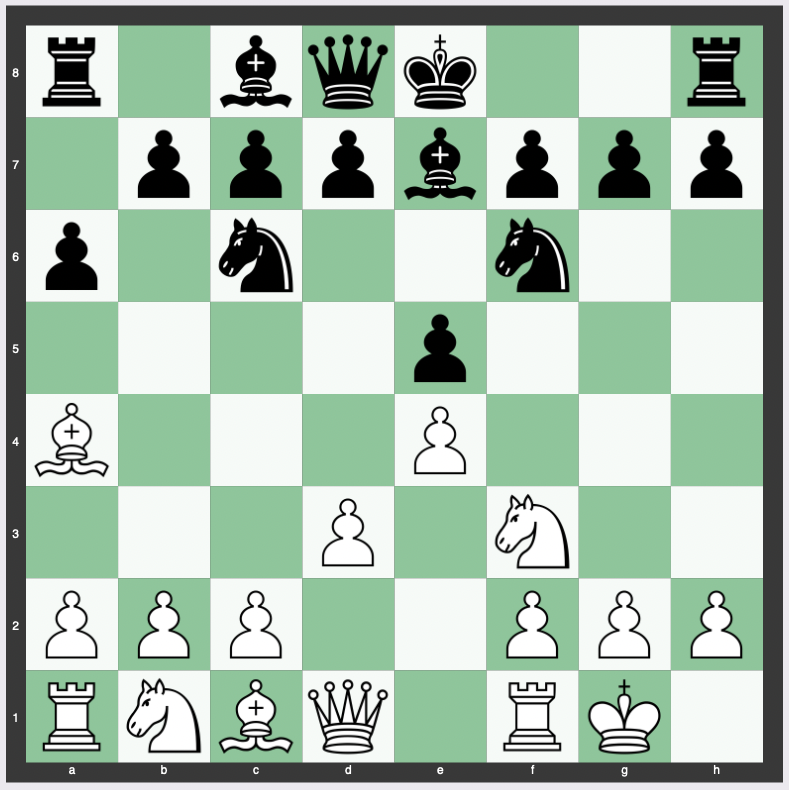Within the Ruy Lopez opening, there are many variations, with the Modern Line Ruy Lopez characterized by the moves 1. e4 e5 2. Nf3 Nc6 3. Bb5 a6 4. Ba4 Nf6 5. O-O Be7 6. d3.
This article will explore this specific line, delving into its move order, theory, strategy, variations, history, suitability for different levels of players, and its popularity among Grandmasters.
Move Order of the Modern Line of the Ruy Lopez
The move order in this line of the Ruy Lopez is a sequence of well-coordinated steps that lead to a complex and rich middlegame.
- e4 e5 initiates the opening, controlling the center.
- Nf3 Nc6 develops the knights, attacking and defending the central e5 pawn.
- Bb5 pressures the knight on c6, threatening potential exchanges.
- Ba4 after a6 retreats the bishop, maintaining pressure.
- O-O Be7 prepares kingside castling for both sides.
- d3 solidifies the central pawn structure.
Theory, Strategy, and Purpose of the Modern Line
The theory behind this line is deeply rooted in classical chess principles.
Control of the center is prioritized.
Development of pieces is harmonious and efficient.
The purpose of this line is to create a flexible and solid position, allowing various strategic plans.
It often leads to a slow buildup, where understanding positional nuances becomes key.
6. d3 is generally considered the strongest option in the line: 1. e4 e5 2. Nf3 Nc6 3. Bb5 a6 4. Ba4 Nf6 5. O-O Be7 (after 6. Re1).
6. d3 gives white an edge of approximately +0.25 to +0.30.
Variations of the Modern Line
There are numerous variations that can arise from this position.
The immediate 6…d6 is a common continuation, supporting the central pawn.
6…b5 followed by 7. Bb3 is another typical plan, gaining space on the queenside.
The choice of variations can lead to vastly different types of positions, allowing for rich and diverse gameplay.
Continuation Lines from the Modern Line of the Ruy Lopez
Some sample continuation lines from the Modern Line of the Ruy Lopez:
6… b5 7. Bb3 d6 8. a4 Bd7 9. Bd2 O-O 10. axb5 axb5 11. Nc3 Na5 12. Nd5 Nxd5 13. Bxd5 c6 14. Ba2 c5 15. Bd5 Nc6 16. Rxa8 Qxa8 17. b4 Qa6 18. bxc5 dxc5
6… b5 7. Bb3 d6 8. c3 O-O 9. Re1 h6 10. a4 Bd7 11. Bc2 Re8 12. Nbd2 Bf8 13. h3 Ne7 14. d4 Ng6 15. Nf1 c6 16. Be3 Qc7
6… b5 7. Bb3 d6 8. a4 Bd7 9. c3 h6 10. h3 O-O 11. Bc2 Re8 12. Nbd2 Bf8 13. Re1 b4 14. d4 Rb8 15. d5 bxc3 16. bxc3 Na5 17. Bd3 c6 18. c4 Qc7 19. Ba3
6… b5 7. Bb3 d6 8. c3 O-O 9. a4 Bd7 10. Bc2 Re8 11. Re1 h6 12. Nbd2 Rb8 13. Nf1 b4 14. Ng3 bxc3 15. bxc3 Bf8 16. d4 Na5 17. h3 c6 18. Nd2 Qc7 19. Ba3 Be6 20. Qf3 Nb3 21. Bxb3 Bxb3 22. Nf5 Kh7 23. Ne3 Be6 24. d5 Bd7 25. c4 a5 26. Ndf1 Rb3 27. Reb1 Rxb1 28. Rxb1
History of the Modern Line
The Ruy Lopez has been played for over 400 years, with the modern line becoming more popular in the 20th century.
Many World Champions and leading theorists have contributed to the development of this line.
Its enduring popularity is a testament to its depth and richness.
Whether the Modern Line Ruy Lopez Is Good for Beginners or Intermediates
This line of the Ruy Lopez is suitable for both beginners and intermediate players.
For beginners, it offers a solid foundation in classical opening principles.
For intermediate players, it provides a platform to explore more complex strategic ideas.
Its adaptability makes it a valuable tool for players at various stages of development.
How Often Is the Modern Line Ruy Lopez Played at the Grandmaster Level?
This line is frequently played at the Grandmaster level.
It has been employed in World Championship matches and top-tier tournaments.
Its strategic complexity and rich tactical possibilities make it a favorite among elite players.
The Ruy Lopez – Basic Plans, Ideas & Strategies – Chess Openings – IM Andrey Ostrovskiy
Conclusion
The modern line of the Ruy Lopez, characterized by 1. e4 e5 2. Nf3 Nc6 3. Bb5 a6 4. Ba4 Nf6 5. O-O Be7 6. d3, is a fascinating and versatile opening.
It encapsulates the essence of chess strategy, offers a wide array of variations, and has a rich historical legacy.
Suitable for players of all levels and frequently seen in Grandmaster play, it continues to be a vital part of the chess landscape.
Studying and understanding this line can provide valuable insights into the game and contribute to a player’s overall growth and success.


